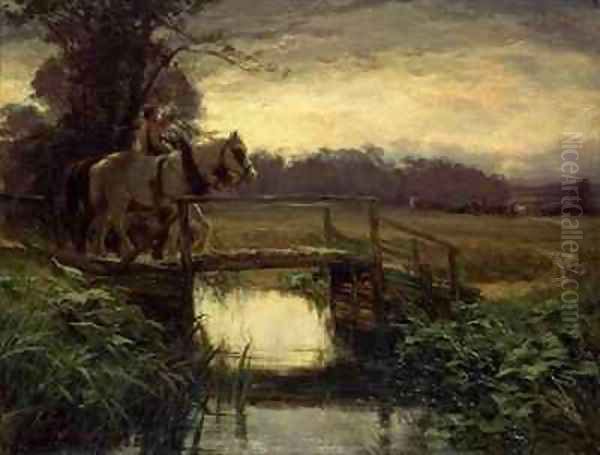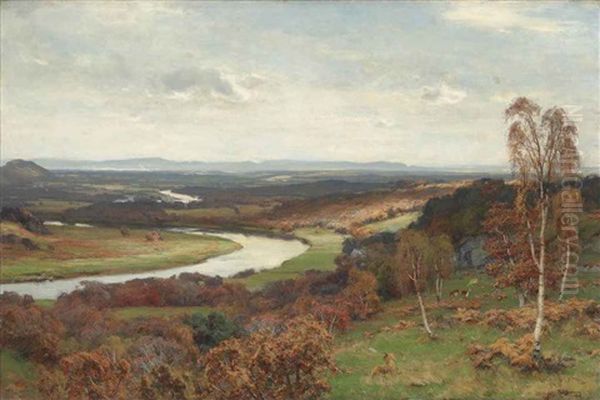David Farquharson stands as a significant figure in the rich tapestry of Scottish landscape painting during the latter half of the 19th century. Born in Blairgowrie, Perthshire, Scotland, in 1840, his journey into the art world was not one paved by formal academic training but rather forged through personal dedication and innate talent. His legacy is defined by his evocative depictions of the Scottish Highlands and other British landscapes, marked by a sensitive handling of light and atmosphere that continues to resonate with viewers today.
Early Life and Artistic Beginnings
Farquharson's entry into the professional world began not with a brush and canvas, but with the tools of a decorator. He initially undertook an apprenticeship in this trade, a practical start that perhaps honed his eye for detail and composition in ways different from traditional art schooling. Despite this seemingly unrelated beginning, the call of fine art proved strong. Farquharson became a largely self-taught artist, diligently studying the natural world and the works of other painters to develop his skills.
His public debut as a landscape painter occurred in 1868 when he exhibited his first work in Edinburgh. This marked the beginning of a long and respected career dedicated primarily to capturing the diverse beauty of the British Isles. During these formative years, he traveled, particularly through southern Scotland and parts of Ireland, absorbing the landscapes that would become central to his artistic output. Concurrently, he maintained a practical foothold by running a house decorating business in partnership with his brother, balancing artistic pursuits with commercial realities.
Artistic Development and Influences
Farquharson's artistic vision was shaped by careful observation and an appreciation for certain European masters. His work shows a clear affinity with the French Barbizon School painters, particularly Jean-Baptiste-Camille Corot. From Corot, one can see a shared interest in tonal harmony and the poetic rendering of landscape light. The influence of Gustave Courbet's realism can also be discerned in the truthful depiction of terrain and natural forms.

Furthermore, Farquharson looked towards the masters of the Dutch Golden Age. The Dutch School's profound understanding of atmosphere, sky, and the subtle interplay of light across land and water seems to have resonated with Farquharson's own sensibilities, informing his approach to capturing the often-dramatic weather conditions of his native Scotland.
His subject matter primarily focused on the landscapes of Scotland, especially the majestic Highlands. However, his artistic explorations also took him to Northern England and the coastal regions of Cornwall, broadening his repertoire of scenes. A key characteristic of his work was the meticulous attention paid to the transient effects of light and shadow, capturing specific moments of the day or seasons with remarkable fidelity. His paintings often combined accurate topographical representation with a deeper, almost social, study of the land and its character.
While largely self-taught, some accounts suggest a connection, possibly later in his development or through informal guidance, with the esteemed Scottish landscape painter Peter Graham (1836-1921). Graham himself was known for his dramatic Highland scenes, often featuring cattle, and any association would have placed Farquharson within the orbit of established Scottish artistic practice. Regardless of direct tutelage, Farquharson carved his own path, developing a distinct and personal style.
Signature Style and Themes
David Farquharson is best remembered as a painter of the Scottish landscape, particularly the Highlands. His preferred medium was oil on canvas, which allowed him to build up rich textures and capture the luminosity he sought. His style evolved throughout his career. Early works often display a tighter handling and a high degree of detailed realism, meticulously rendering foliage, rock formations, and water surfaces.
As he matured, his brushwork often became broader and more expressive, suggesting form and atmosphere rather than delineating every detail. This later style allowed for a greater emphasis on the overall mood and the emotional impact of the landscape. He demonstrated a particular mastery in depicting the interplay of light and weather – the soft haze of a misty morning, the dramatic shadows cast by rolling clouds, or the warm glow of sunset over moorland.
Several works stand out as representative of his oeuvre. "Grey Morning," exhibited in 1878, exemplifies his skill in capturing atmospheric effects, likely depicting a quiet, mist-laden rural scene with subtle tonal gradations. "Meadow and Moorland" from 1881 showcases his understanding of the textures and forms of the Scottish countryside, balancing detailed observation with a sense of expansive space.

Other notable titles mentioned include "Birnam Wood," evoking Shakespearean connections and the ancient forests of Scotland, and "Dark Tintagel," suggesting a venture to the dramatic Cornish coast, famed for its Arthurian legends and rugged cliffs. These titles hint at a romantic sensibility underlying his naturalistic approach, an appreciation for the history and lore embedded within the landscapes he painted. His unique ability to handle light, shadow, and colour became a hallmark of his style, lending his canvases a distinct vibrancy and depth.
Professional Recognition and Career
Farquharson's dedication and evolving skill did not go unnoticed. Following his debut in 1868, he became a regular exhibitor at the Royal Scottish Academy (RSA) in Edinburgh, the premier institution for art in Scotland. His consistent presence at the RSA annual exhibitions cemented his reputation within the Scottish art world. The provided information suggests he exhibited there until 1904. While specific dates of membership can vary in sources, his long association underscores his acceptance and standing among his peers. Standard records indicate he was elected an Associate of the RSA (ARSA) in 1882 and achieved full Academician status (RSA) later, possibly around 1905, near the end of his life.
His paintings found favour not only with critics and fellow artists but also with the public and collectors. His depictions of familiar and beloved Scottish scenes were popular, leading to commercial success. His works were acquired for numerous private collections, and today they are held in various public institutions and museums, ensuring his contribution to Scottish art remains accessible. He was considered a highly regarded figure, respected for his technical proficiency and his authentic portrayal of Scotland's natural heritage.
Family Background and Context
David Farquharson hailed from a family with deep roots in Scottish history, the Clan Farquharson. This Highland clan traces its origins back to Alexander Ciar Mackintosh of Rothiemurchus, a son of Shaw of Rothiemurchus. The clan established itself prominently in Aberdeenshire, particularly in the valley of the River Dee (Deeside). The family name became synonymous with the region around Braemar and Ballater.
The Farquharsons were historically significant landowners and played roles in Scotland's turbulent past. Ancestors fought and died in key battles, such as Finlay Mor Farquharson, the clan's standard-bearer who fell at the Battle of Pinkie Cleugh in 1547. The clan was also involved in the conflicts surrounding the Marquis of Montrose in the 1640s and Viscount Dundee in 1689.
During the Jacobite Rising of 1745, the clan, under John Farquharson of Invercauld, joined the cause of Prince Charles Edward Stuart as part of the Clan Chattan confederation. This loyalty came at a cost, with John Farquharson being captured after the Battle of Culloden and imprisoned for a time in the Tower of London. The family history is one of resilience, martial prowess, and deep connection to the Highland landscape.
The clan structure included several important branches, such as those of Craignyti, Monaltrie, Whitehouse, and Finzean. The family motto, "Fide et Fortitudine" (By Faith and Fortitude), and their crest, a demi-lion rampant holding a sword, speak to this heritage of loyalty and strength.
It is important to note that David Farquharson the painter should not be confused with his slightly younger and perhaps even more widely known contemporary, Joseph Farquharson (1846-1935). Joseph was the Laird of Finzean, famed for his snow scenes often featuring sheep, and sometimes referred to as 'The Painting Laird'. While both were prominent landscape artists from the broader Farquharson clan network and contemporaries active in the same artistic circles, their immediate family lines and specific life circumstances differed. Some sources occasionally conflate details between the two artists, but David Farquharson of Blairgowrie and Joseph Farquharson of Finzean were distinct individuals and artists. David's own connection to the Lairdship of Finzean is not typically documented, though the provided source text does link him to it; this likely stems from the common confusion with Joseph.
Contemporaries and the Scottish Art Scene
David Farquharson worked during a vibrant period for Scottish art, particularly landscape painting. He was part of a generation that built upon the foundations laid by earlier artists like Horatio McCulloch (1805-1867), who had popularized dramatic Highland scenery. Farquharson's contemporaries included a diverse group of talented painters.
Naturally, Joseph Farquharson (1846-1935) was a key contemporary, sharing a focus on Scottish scenes, though with his own distinct specialisation in snow and animals. Perhaps the most influential landscape painter of the era was William McTaggart (1835-1910), whose increasingly free, impressionistic style captured the light and atmosphere of the Scottish coast and countryside with unparalleled vigour. While Farquharson's work generally remained more grounded in realism, the ambient influence of McTaggart's expressive brushwork might be considered.
Other notable landscape painters active during Farquharson's time included George Paul Chalmers (1833-1878), known for his atmospheric and often melancholic scenes before his untimely death; Sam Bough (1822-1878), a prolific watercolourist and oil painter capturing bustling town scenes and landscapes; John MacWhirter (1839-1911), who, like Farquharson, painted Highland landscapes but also travelled widely; and Waller Hugh Paton (1828-1895), known for his detailed, often Pre-Raphaelite-influenced landscapes.
Painters like James Cassie (1819-1879) focused on coastal and marine subjects alongside landscapes. The aforementioned Peter Graham also remained a dominant force with his popular Highland pictures. Beyond landscape, the Scottish art scene boasted major figure painters like Robert Herdman (1829-1888), William Quiller Orchardson (1832-1910), and John Pettie (1839-1893), whose successes in historical and genre painting contributed to the high profile of Scottish art nationally and internationally. Farquharson exhibited alongside many of these artists at the RSA and other venues, participating in the lively artistic dialogue of the time.
Legacy
David Farquharson left behind a significant body of work that celebrates the beauty and diversity of the Scottish landscape. As a largely self-taught artist who rose to prominence, his career is a testament to his dedication and observational skills. He successfully blended the topographical accuracy valued in traditional landscape painting with a sensitivity to light and atmosphere that aligned with broader European trends like the Barbizon School and aspects of Impressionism.
His paintings offer valuable visual records of Scotland, Northern England, and Cornwall in the late 19th century, but they achieve more than mere documentation. They convey a sense of place, capturing the unique moods and character of the landscapes through his masterful handling of colour and light. He holds a secure place in the history of Scottish art as a skilled and sincere interpreter of his natural surroundings.
Conclusion
David Farquharson's contribution to Scottish art lies in his consistent and sensitive portrayal of the nation's landscapes. From his beginnings as an apprentice decorator to his status as a respected exhibitor at the Royal Scottish Academy, he developed a distinctive style influenced by both Dutch masters and French naturalism. His works, particularly those depicting the Scottish Highlands, are admired for their atmospheric depth, their nuanced rendering of light, and their honest engagement with the natural world. Though perhaps sometimes overshadowed by contemporaries like McTaggart or his namesake Joseph Farquharson, David Farquharson remains an important figure whose paintings continue to offer compelling visions of Scotland's enduring beauty.